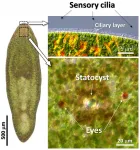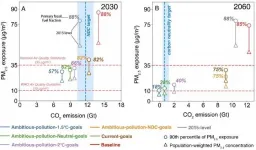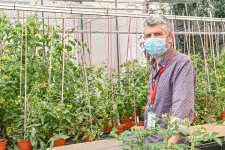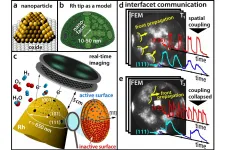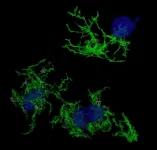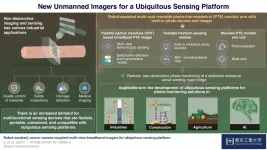A tripartite-chromosome E. coli strain allows the chromosome isolation and implantation
The technology for genome installation in model organisms
2021-05-21
(Press-News.org) The issue of concern was that the Escherichia coli (E. coli) genome, consisting of 4.6 million base pairs of a single circular DNA, is too large to manipulate following the extraction and transfer to other bacteria.
In the present study, a group of Rikkyo University researchers led by Assistant Professor Takahito Mukai and Professor Masayuki Su'etsugu has succeeded in splitting the E.coli genome into tripartite-genome of 1 million base pairs per genome (split-genome) using the smallest E. coli genome strain established so far. In addition, they successfully extracted the split-genome from bacteria and installed it in other E. coli.
It is a major breakthrough that E. coli could stably proliferate even after the bacterial genome was split into tripartite-genome. Going forward, it is imperative to clarify how the replication and distribution of the tripartite-genome are controlled. Also, this research group has been developing the technology for synthesizing gigantic DNA without using cells (cell-free) and reported a cell-free technique for amplifying 1 million base pairs of circular DNA. In the future, the installation of cell-free synthesized split genomes in E. coli is expected to lead to the creation of artificial E. coli with designed valuable functions, such as material production.
This achievement is expected to lead to the clarification of the mechanism of genome replication/segregation and also to the application of tools in synthetic biology to convert the genome, the blueprint of life, so that we can create functionally designed life. The results in the present study have been published in the online version as a breakthrough paper in Nucleic Acids Research on April 28, 2021.
INFORMATION:
The research was supported by JST's Strategic Basic Research Program, Core Research for Evolutional Science and Technology (CREST).
[Attachments] See images for this press release:

ELSE PRESS RELEASES FROM THIS DATE:
2021-05-21
All living organisms are equipped with sensory organs to detect changes in their surrounding environment. It may not immediately strike us as obvious but, similar to how we can sense heat, cold, light, and darkness, we are also extremely adept at sensing gravity. In our case, it is our inner ear that does this job, helping us maintain balance, posture, and orientation in space. But, what about other organisms, for instance invertebrates that lack a backbone?
The gravity sensing organ in some aquatic invertebrates, known as a "statocyst," is, in fact, rather fascinating. The statocyst is essentially a fluid-filled sac with sensory cells lining its inner wall and a small, mineralized ...
2021-05-21
[Highlights]
- Integrated cyber attack analysis platform "NIRVANA Kai" newly supports IPv6 and enhances its functions.
- Observation of IPv6 communications, collection of IPv6-related alerts, and real-time visualization of IPv6 networks.
- Expected to simplify security operations in IPv6 networks.
[Abstract]
The Cybersecurity Laboratory of the National Institute of Information and Communications Technology (NICT, President: TOKUDA Hideyuki, Ph.D.) has enhanced its cyber attack integrated analysis platform "NIRVANA Kai" to support the Internet Protocol version ...
2021-05-21
China's clean air policies have substantially reduced PM2.5 air pollution in recent years. Yet >99% of Chinese population is still exposed to PM2.5 concentrations in excess of the World Health Organization (WHO) Air Quality Guidelines of 10 μg/m3. Climate actions targeting to reduce fossil fuel consumption also have substantial air quality benefits. The announcement of ambitious climate commitment to achieve carbon neutrality by 2060 may fuel the power to long-term air quality improvement in China.
Combining Global/China's climate mitigation pathways (i.e. global 2°C- and 1.5°C-pathways, NDC pledges, and carbon neutrality goals) and local clean ...
2021-05-21
An international research group involving the Institute of Molecular and Cellular Biology of Plants (IBMCP), a joint centre of the Universitat Politècnica de València (UPV) and the Spanish National Research Council (CSIC), has discovered that a genetic mechanism, called CHLORAD, which is involved in the ageing of plant leaves, also plays a decisive role in the tomato ripening process. Thus, tomatoes with an activated CHLORAD system turn red more quickly, and accumulate more lycopene, a compound beneficial to health. The results, which have been published in the latest issue of the journal Nature Plants, will lead to better quality tomatoes.
The ripening of most fleshy fruits gives them attractive colours and smells, which is a trick of the plant to spread its seeds ...
2021-05-21
Most of commercial chemicals are produced using catalysts. Usually, these catalysts consist of tiny metal nanoparticles that are placed on an oxidic support. Similar to a cut diamond, whose surface consists of different facets oriented in different directions, a catalytic nanoparticle also possesses crystallographically different facets - and these facets can have different chemical properties.
Until now, these differences have often remained unconsidered in catalysis research because it is very difficult to simultaneously obtain information about the chemical reaction itself and about the surface structure of the catalyst. At TU Wien (Vienna), this has now been achieved by combining different microscopic methods: with ...
2021-05-21
SINGAPORE, 21 May 2021 - Alzheimer's Disease is the most common form of dementia and is characterised by the build-up of amyloid plaques in the brain. Microglia, the immune sentinels of the brain, are not only responsible for eliminating foreign invaders, but also maintaining brain homeostasis by clearing toxic waste such as the amyloid plaques.
However, the role of microglia in Alzheimer's Disease and its relationship to amyloid plaque accumulation remain unclear. Now, a team of scientists from Duke-NUS Medical School and Monash University have found the gene expression signatures underlying microglia associated ...
2021-05-21
More than 100 kg of highly toxic uranium (U) and plutonium (Pu) was dispersed in the form of tiny 'hot' radioactive particles after the British detonated nine atomic bombs in remote areas of South Australia, including Maralinga.
Scientists say that these radioactive particles persist in soils to this day, more than 60 years after the detonations. Previously, we had limited understanding of how Pu was released from these "hot" particles into the environment for uptake by wildlife around Maralinga.
But now, a new study published today in Scientific Reports and led by Monash University researchers warns that the particles are actually more ...
2021-05-21
A new study shows that the current rate of biodiversity decline in freshwater ecosystems outcompetes that at the end-Cretaceous extinction that killed the dinosaurs: damage now being done in decades to centuries may take millions of years to undo.
The current biodiversity crisis, often called the 6th mass extinction, is one of the critical challenges we face in the 21st century. Numerous species are threatened with extinction, mostly as a direct or indirect consequence of human impact. Habitat destruction, climate change, overexploitation, pollution and invasive species are among the main causes for Earth's biota to decline rapidly.
To investigate the tempo of extinction and predict recovery times, an international team of evolutionary biologists, paleontologists, geologists and modelers ...
2021-05-21
One of the key aspects of academic and industrial research today is non-destructive imaging, a technique in which an object or sample is imaged (using light) without causing any damage to it. Often, such imaging techniques are crucial to ensuring safety and quality of industrial products, subsequently leading to growing demands for high-performance imaging of objects with arbitrary structures and locations.
On one hand, there has been tremendous advancements in the scope of non-destructive imaging regarding the region of electromagnetic (EM) spectrum it can access, which now ranges from visible light to as far as millimeter waves! On the other, imaging devices have become flexible and wearable, enabling stereoscopic (3D) visualization ...
2021-05-21
Because individual atoms or molecules are 100 to 1000 times smaller than the wavelength of visible light, it is notoriously difficult to collect information about their dynamics, especially when they are embedded within larger structures.
In an effort to circumvent this limitation, researchers are engineering metallic nano-antennas that concentrate light into a tiny volume to dramatically enhance any signal coming from the same nanoscale region. Nano-antennas are the backbone of nanoplasmonics, a field that is profoundly impacting biosensing, photochemistry, solar energy harvesting, and photonics.
Now, researchers at EPFL led by Professor Christophe Galland at the School of Basic Sciences ...
LAST 30 PRESS RELEASES:
[Press-News.org] A tripartite-chromosome E. coli strain allows the chromosome isolation and implantation
The technology for genome installation in model organisms

